Table of contents
- Comparison test Harley-Davidson chopper
- Data: Harley-Davidson Street Bob (Wide Glide)
- MOTORCYCLE measurements / conclusion
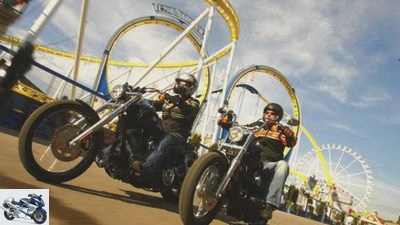
Bilski
motorcycles
Comparison test: Harley-Davidson chopper
Comparison test
Harley-Davidson chopper
With the Harley-Davidson model range, it’s a little like going to the booth at the fair. The company praises their main prizes, the lucky winner is not sure which one to take. New Wide Glide or Old Street Bob which one is the big lot?
Stefan Kaschel
10/22/2009
We’ve had that before.” If ever there was a company to which this statement applies, it is Harley Davidson. No matter whether 10, 20 or 33 1/2 years in the long history of the “Motor Company” there is always an occasion to quote the past. In the current case, the 30th anniversary of the “Wide glide”, of course, according to the company’s tradition, with a new edition. However, there is a small problem. Since 2006, Milwaukee has also been producing the Dyna Street Bob with an identical engine, almost identical chassis and, miraculously, very similar systems. “With the character of a radical chopper” one, namely the Wide Glide, “stripped down for what matters” the street bob. Original sound press release. Now who knows that “to chop” in English “chop off” means that a chopper is a motorcycle from which everything superfluous has been removed, rightly asks: What’s the difference, especially since both are based on the Dyna chassis with conventional struts and the Twin Cam 96 engine with 1548 cubic centimeters? Old Harley-hands have the answer. “In detail”, they proclaim knowingly, referring to the steering head angle (54 degrees) of the Wide Glide, which is five degrees flatter. Or the larger front wheel with the narrower tire, the wider rear wheel, the other exhaust system. Everything is correct, everything can be seen and felt. But all marginalia, measured against what really matters.
Buy complete article
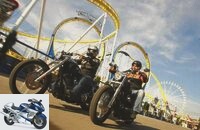
Comparison test
Harley-Davidson chopper
6 pages) as PDF
€ 2.00
Buy now
Quite clear: With such identical conditions, it can only be the sitting position that makes the difference. The starting point for this is the identical bench seat, which places the driver just 680 millimeters above the ground. But that is where the ergonomic similarities clearly end.
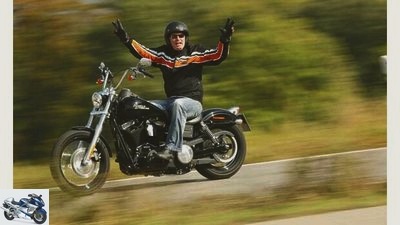
Bilski
Harley-Davidson Street Bob.
Only handlebars and footrests turn the Wide Glide into the Wide Glide and the Street Bob into the Street Bob, because Harley has distributed what chopper riders really want in equal amounts across both models. Why is? To put it badly: To sit like a monkey on the grindstone. So prevents a half-height “Ape hanger” On the Street Bob, armpit sweat is as reliable as the direct feeling to the front wheel, while on the Wide Glide the footpegs are attached so far forward on the frame beams that the rump and spine form the natural continuation of the suspension struts and thus actively move from a modest 79 millimeters of travel into the Attenuation tasks are integrated. This division of the instruments of torture between both vehicles is not consistent in terms of holistic malaise and therefore not as bad as it sounds. But it leaves the fan alone with a far-reaching decision: What kind of penance is appropriate to humbly make me mature for the illustrious chopper circle? A few small decision-making aids: The Street Bob’s advantage is that the chrome-plated air filter on one side and the horn on the other massage the lower legs in time with the V2 and so the “good vibrations” Noticeably passed on at any time, while the engine suspension in rubber mounts on the Wide Glide cushions a lot due to the lack of direct contact. In addition, it is the more digestible rear wheel dimension (160 instead of 180 millimeters), but above all the Michelin tires, which make handling the Street Bob a little friendlier (and safer when driving in the rain).
For the Wide Glide, however, speaks the “Peter Fonda Effect”. As long as you don’t go over 100 km / h or tackle corners at a committed pace, it feels really casual when your feet under the steering head let the wind whistle through your toes. Then the sixth, designed as overdrive, cloned in (so from 70 km / h without shaking or shaking), and it goes forward, towards the horizon. On the occasion of this, one can repeatedly rejoice or wonder what culture and manners Harley has developed into its Big Twins in the meantime. A silky smooth throttle response and almost zero play in the drive train almost completely minimize load change reactions. Nothing jerks or clacks, it goes straight forward and smoothly, and even very deeply from the lower speed range. A maximum torque of around 120 Newton meters is already available at around 3500 rpm, but from 2000 rpm and up to around 5000 rpm you can chopper carefree before the air becomes thin for the two-valve engines with their two camshafts below.
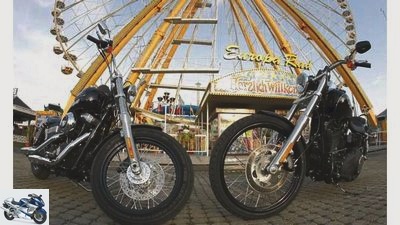
Bilski
Inferno of the engines? At the fair, only the loud tones count. And of course only the coolest guys.
190 km / h are then possible for the Street Bob with its driver clinging to the Ape Hanger, 195 for the Wide Glide. Theoretically, because seriously nobody will want to do that to themselves. The courageous intermediate sprint already. No, not with downshifts and all that uncool hocus-pocus. Just like that, in fifth gear, because for such exercises the forever long sixth should theoretically have a break of up to 250 km / h. The fact that the Street Bob is doing a little better here than the Wide Glide is less due to the six kilograms lower weight than to the astonishingly fuller middle (see performance curves). How come Probably the different exhaust systems are to blame. The real chopper fan doesn’t care. As well as the resulting better performance and the slightly higher consumption.
Data: Harley-Davidson Street Bob (Wide Glide)
Engine:
Air-cooled two-cylinder four-stroke 45-degree V-engine, crankshaft lying transversely, two lower, chain-driven camshafts, two valves per cylinder, hydraulic valve lifters, bumpers, rocker arms, dry sump lubrication, injection, Ø 46 mm, regulated catalytic converter, 493 W alternator, battery 12 V / 19 Ah, mechanically operated multi-disc oil bath clutch, six-speed gearbox, toothed belt, secondary ratio 66:32.
Bore x stroke 95.3 x 111.1 mm
Cubic capacity 1585 cm3
Compression ratio: 9.2: 1
Rated output: 56.0 (57) kW, 76 (78) PS at 5350 (5250) / min
Max. Torque: 123 (126) Nm at 3125 (3500) / min
Landing gear:
Double loop frame made of steel, telescopic fork, Ø 49 mm, two-arm swing arm made of steel, two
Suspension struts, adjustable spring base, front disc brake, Ø 300 mm, four-piston fixed caliper, rear disc brake, Ø 292 mm, double-piston floating caliper.
Spoked wheels with aluminum rims: 2.15 x 19 (2.15 x 21); 4.50 x 17
Tire: 100 / 90-19 (80 / 90-21); 160 / 70-17 (180 / 60-17)
Tires in the Michelin Scorcher test “31” (Dunlop GT 502)
Dimensions + weights:
Wheelbase 1630 (1715) mm, steering head angle 61.0 (56.0) degrees, caster 119 (132) mm, spring travel f / r 127/79 mm, seat height * 690 (670) mm, weight with a full tank * 300 (306) kg , Payload * 192 (186) kg, tank capacity / reserve 17.3 / 3.4 liters.
Warranty: two years
Service intervals: 8000 km
Colors: red, black (silver, blue)
Power variant: Street Bob 25 kW at 4750 rpm
Price: 12,995 (14795) euros
Additional costs: around 350 euros
MOTORCYCLE measurements / conclusion
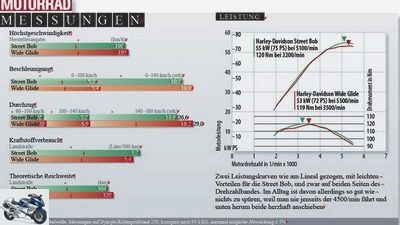
BILLION
MOTORCYCLE conclusion:
How you sit down, that’s how you drive. In fact, it’s the seating position that makes all the difference between the new Wide Glide and the old Street Bob. Arms up or legs forward – this is how the two chopper philosophies are defined, everyone has to decide for themselves. And who doesn’t like one or the other? Should rather stroll through the hustle and bustle or ride a normal motorcycle.
Related articles
-
Comparison test Honda CBF 1000 F and Suzuki Bandit 1250 S
Bilski 32 pictures Bilski 1/32 The CBF 1000 F looks more elegant, dignified, sleeker. The 1250 Bandit comes across as beefier, more powerful with a more…
-
Mid-range naked bikes in a comparison test
fact 23 pictures fact 1/23 The middle class has changed. 100 hp, at least 750 cc and 200 km / h are nothing unusual here. fact 2/23 We test three…
-
48 hp motorcycles 300 cc entry level comparison test 2018
Rossen Gargolov 23 pictures Rossen Gargolov 1/23 Right in the middle of the golden October. Rossen Gargolov 2/23 The test field consists of entry-level…
-
Comparison test: Honda Hornet, Kawasaki Z 750, Suzuki GSR 600
Jahn motorcycles Comparison test: Honda Hornet, Kawasaki Z 750, Suzuki GSR 600 Comparison test: Honda Hornet, Kawasaki Z 750, Suzuki GSR 600 ABS shooters…
-
Comparison test: Honda CBF 1000 Silverline, Suzuki Bandit 1250 S, Yamaha FZ1 Fazer
Jahn 22nd pictures Honda 1/22 Honda CBF 1000 Honda 2/22 Honda CBF 1000 Zdrahal 3/22 Presentation at the fair in Paris. Honda 4/22 Honda CBF 1000 Honda…
-
Product test: top-class sports helmets in comparison
2snap clothing Helmets Product test: top-class sports helmets in comparison Comparative test sports helmets of the upper class Well protected with the…
-
Comparison test: Honda CBF 600 S and Kawasaki ER-6f
Gargolov motorcycles Comparison test: Honda CBF 600 S and Kawasaki ER-6f Comparison test Honda CBF 600 S and Kawasaki ER-6f They don’t shine in the…
-
Comparison test: The winners of the Alpine Masters 2005 – 2011
jkuenstle.de 17th pictures Jkuenstle.de 1/17 Meeting of the Alpen Masters winners (from left): BMW R 1200 GS (2010/11), Honda CB 1300 (2009), BMW R 1200…
-
Comparison test MV Agusta Turismo Veloce 800 and Yamaha MT-09 Tracer
Bilski 19th pictures MOTORCYCLE 1/19 Power on the crankshaft. Measurements on the Dynojet roller test stand 250, corrected according to 95/1 / EG,…
-
Comparison test Kawasaki Versys 650, Suzuki V-Strom 650 and Yamaha Tracer 700
www.factstudio.de 27 pictures www.factstudio.de 1/27 Crossover comparison test with the Kawasaki Versys 650, Suzuki V-Strom 650 and Yamaha Tracer 700….